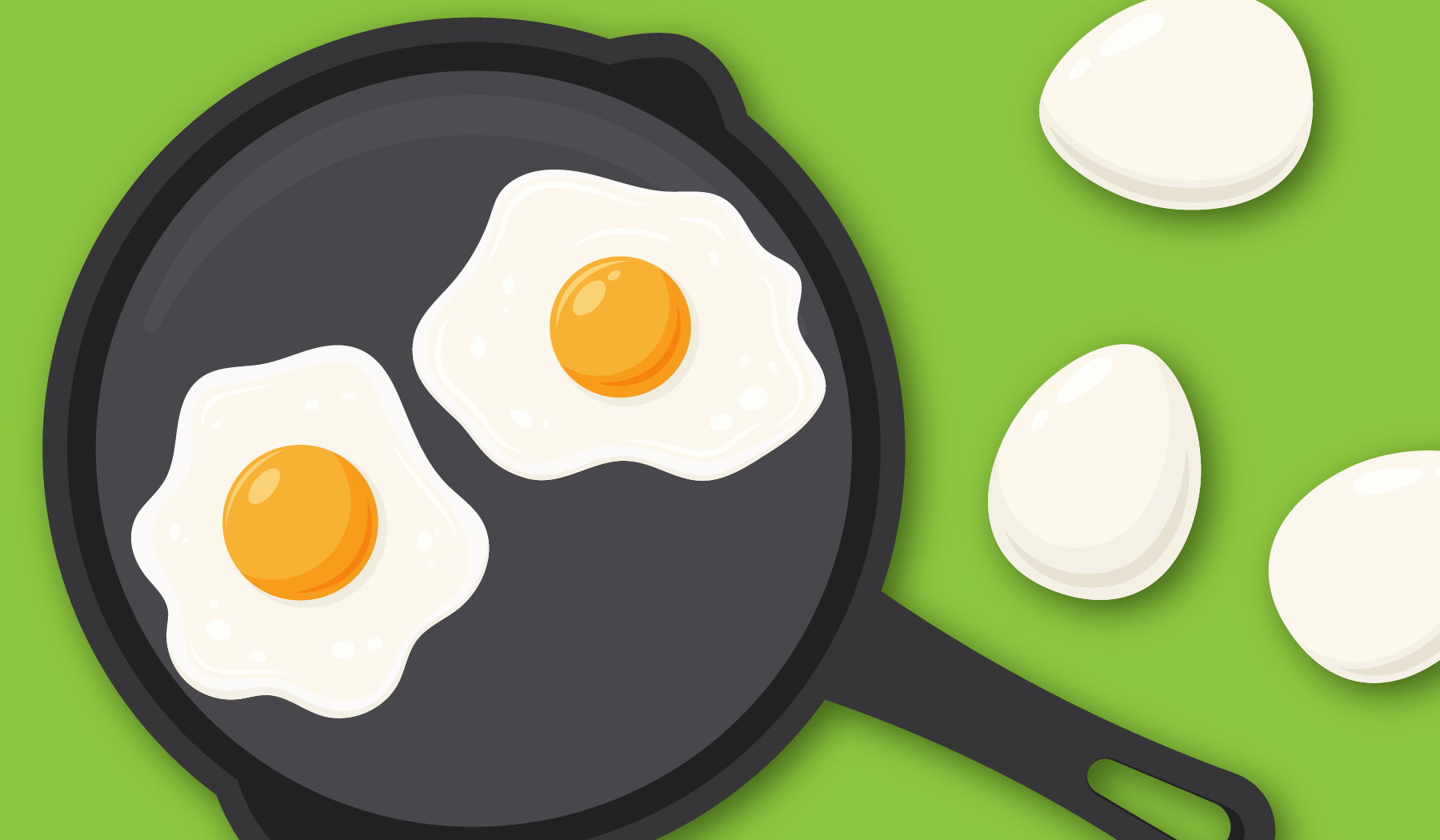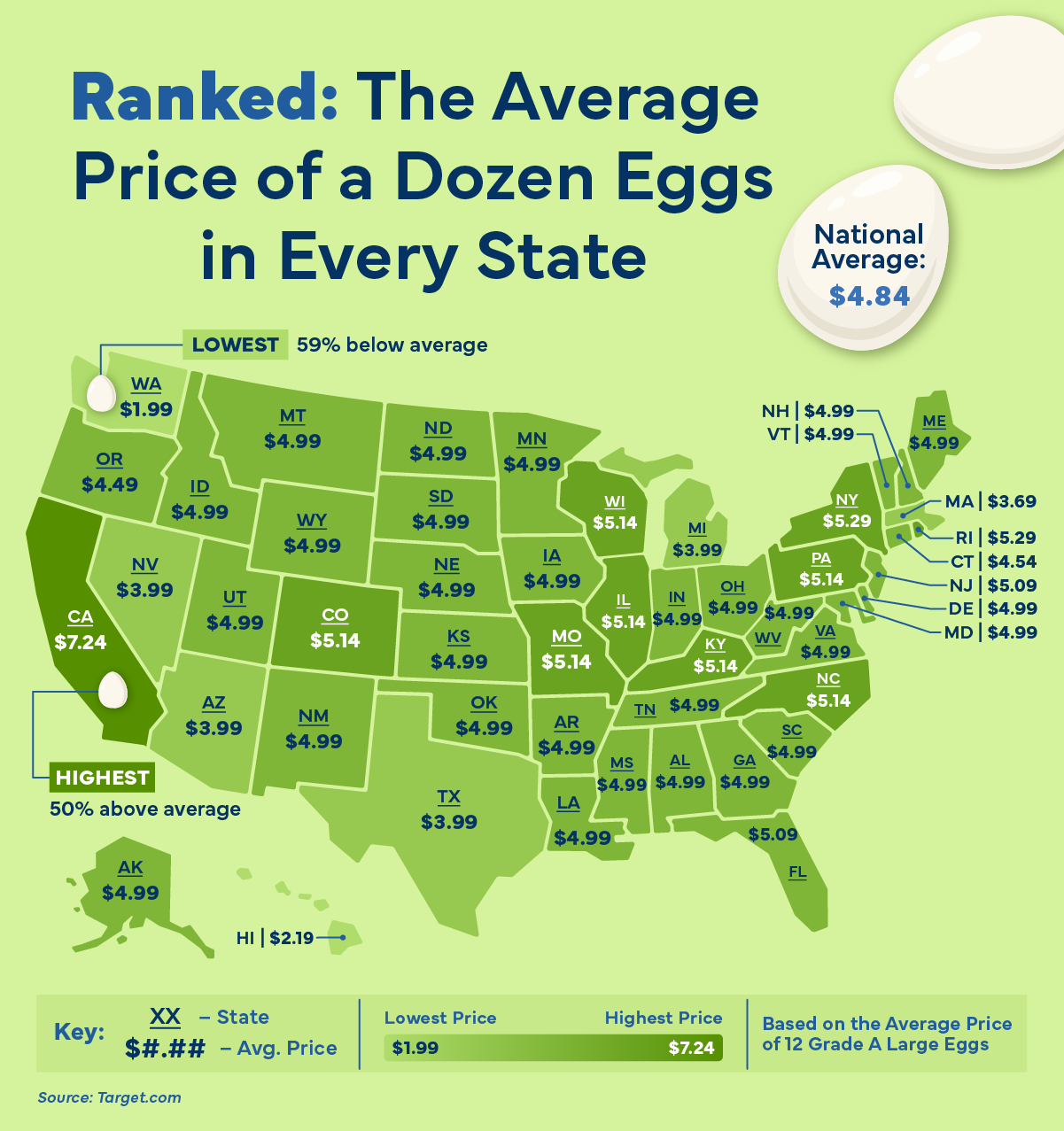
Finding an affordable dozen eggs has become more challenging in the past year. In April 2024, the national average price for a dozen eggs was $2.70. However, ongoing impacts from a nationwide bird flu outbreak have driven prices sharply upward, culminating in a record high of $8.17 per dozen in March 2025.
The outbreak has led to the euthanization of over 150 million birds, most of them egg-laying chickens. With the national supply heavily affected, egg prices have seen notable shifts across the country.
This study examines how egg prices now vary from state to state and highlights the most popular egg preparation styles across the country, offering insights into both the financial and cultural landscape of a household staple — an “eggnalysis,” if you will.
How Much Does a Dozen Eggs Cost In Each State?

The national average price for a dozen eggs currently sits at $4.84. However, depending on where you live, egg prices can vary significantly from this benchmark.
States With the Highest Average Price of a Dozen Eggs
- California – $7.24 (50% above average)
- Rhode Island – $5.49 (13% above average)
- New York – $5.29 (9% above average)
- Colorado* – $5.14 (6% above average)
- Illinois* – $5.14 (6% above average)
- Kentucky* – $5.14 (6% above average)
- Missouri* – $5.14 (6% above average)
- North Carolina* – $5.14 (6% above average)
- Pennsylvania* – $5.14 (6% above average)
- Wisconsin* – $5.14 (6% above average)
*indicates a tie
Despite national efforts to stabilize the cost of groceries, California stands out with the most expensive eggs in the country, at $7.24 per dozen—over 50% higher than the national average. Other states like Rhode Island and New York also face steep prices, potentially driven by factors such as regional supply chain challenges and higher overall living costs. Interestingly, multiple states, including Colorado, Illinois, and Pennsylvania, all share the same average price point, indicating a somewhat even distribution of egg costs in several regions.
States With the Lowest Average Price of a Dozen Eggs
- Washington – $1.99 (59% below average)
- Hawaii – $2.19 (55% below average)
- Massachusetts – $3.69 (24% below average)
- Arizona* – $3.99 (18% below average)
- Michigan* – $3.99 (18% below average)
- Nevada* – $3.99 (18% below average)
- Texas* – $3.99 (18% below average)
- Oregon – $4.49 (7% below average)
- Connecticut – $4.54 (6% below average)
*indicates a tie
On the opposite end of the spectrum, residents of Washington enjoy the lowest egg prices in the nation, paying just $1.99 per dozen—more than half the national average. Although Hawaii typically sees higher grocery costs due to shipping expenses, its egg prices remain remarkably low at $2.19, likely due to localized production efforts. Meanwhile, states like Arizona, Nevada, and Texas all tie with an affordable average of $3.99 per dozen, reflecting lower production and transportation costs in these regions.
Regional Trends in Egg Pricing
Several notable trends emerge when examining the national landscape of egg costs. Coastal states—particularly those in the Northeast like Rhode Island and New York—tend to experience higher egg prices, possibly due to greater population densities and increased demand. Similarly, California continues to experience high agricultural labor costs and stricter production regulations, which can contribute to elevated grocery prices.
Meanwhile, southern and western states, such as Texas, Arizona, and Nevada, show lower-than-average costs, hinting at a combination of proximity to agricultural centers and less stringent production expenses. States across the Midwest, like Illinois and Wisconsin, hover close to the national average, suggesting relative pricing stability in America’s heartland.
The Most Popular Egg Style in Every U.S. State
To round out our “eggnalysis,” we also explored how Americans prefer their eggs cooked. Using Google Trends data from April 2024 to April 2025, we identified the most popular egg preparation style in each state — and the results show just how much preferences vary across the country.
Most Searched Egg Types Overall
- Scrambled Eggs — 29 states
- Hard-boiled Eggs — 5 states
- Omelette — 3 states
- Fried Eggs — 3 states
- Shirred (Baked) Eggs — 2 states
- Sunny Side Up Eggs — 2 states
Scrambled eggs dominate across the United States, standing as the most popular search in 29 different states. From the South to the Midwest and up to the Northeast, this simple and versatile preparation style holds widespread appeal, particularly in states like Texas, Florida, and Illinois. At current prices, scrambling three eggs a day for a week would cost about $7 in Texas and $12 in Illinois.
Hard-boiled eggs rank second, leading in Idaho, Montana, North Dakota, Wisconsin, and Wyoming — practical choices in states where egg prices generally hover around $4.99 per dozen.
The omelette, while less dominant overall, takes top billing in select states like California, New Jersey, and Hawaii. These regions tend to have diverse culinary cultures, suggesting an appreciation for the customizable, hearty nature of omelettes. Whipping up a three-egg omelette every morning for a week would cost nearly $13 in California, but just under $4 in Hawaii.
Fried eggs remain a strong favorite in Alabama, New York, and Oregon, reflecting a preference for classic, traditional breakfast plates.
Sunny side up eggs are most popular in Georgia and New Mexico, where eggs cost around $4.99 per dozen — making this breakfast classic an affordable daily option.
A few unique results also emerged. Maine and Washington both show a strong preference for shirred (baked) eggs, a lesser-known but rich and comforting preparation. Meanwhile, West Virginia‘s top egg search is for deviled eggs—an outlier that speaks to the state’s deep-rooted love of hearty, communal dishes. Likewise, South Dakota searches most for egg salad, highlighting an inclination toward prepared, versatile foods.
Closing Thoughts
The price of a simple grocery staple like eggs can reveal much about the economic landscape across the United States. With the national average cost of a dozen eggs rising nearly 80% in just one year—it’s more important than ever for individuals and families to stay informed about their everyday expenses. By highlighting both the financial and cultural trends tied to egg prices and preparation styles, this study offers a snapshot of how Americans are navigating the current economic climate.
At Coventry Direct, we understand that managing finances later in life can come with unexpected challenges. That’s why we are committed to providing resources that help seniors stay financially empowered and informed. For those seeking additional ways to boost their retirement savings or meet changing financial needs, determining whether you’re eligible to sell your life insurance policy could be an option worth exploring.
Learn more about how you can uncover the hidden value in your life insurance policy by visiting Coventry Direct today.
Methodology
To find the average price of eggs in each state, we scraped the cost of Good & Gather’s Grade A Large Eggs (12ct) from Target.com in the two largest cities per state. We then averaged those two prices to calculate a statewide egg price.
To uncover how each U.S. state prefers to cook their eggs, we started with a list of popular egg preparations from Happy Egg. Using Google Trends data from April 2024 to April 2025, we analyzed search interest for each cooking style by state. The preparation with the highest relative search interest was deemed the most popular method in that state.

